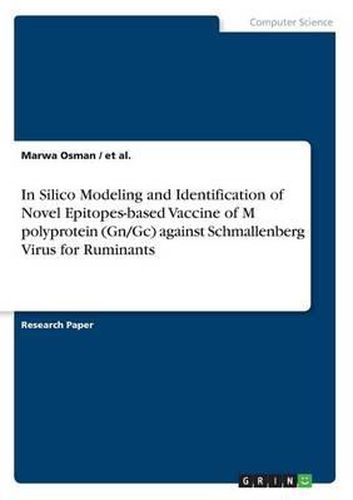Readings Newsletter
Become a Readings Member to make your shopping experience even easier.
Sign in or sign up for free!
You’re not far away from qualifying for FREE standard shipping within Australia
You’ve qualified for FREE standard shipping within Australia
The cart is loading…






Research Paper from the year 2016 in the subject Computer Science - Bioinformatics, language: English, abstract: Schmallenberg (SBV) is a new virus of the Bunyaviridae family within the genus Orthobunyavirus. The viral infection causes mild clinical signs: fever, reduced milk production and diarrhea, as well as considerable economic loss. There is currently no treatment or vaccine for infected animals. We aimed to design a peptide vaccine using an Immunoinformatics approach to stimulate the immune system and reduce the potentially negative effects of using live vaccines. In this study, a total of 47 strains of complete M polyprotein sequence (Gn/NSm/GC) and 61 strains of nonstructural protein in S segment (NSs) of Schmallenberg virus which were chosen for this study were taken from NCBI. Potentially continuous B and T cell epitopes were predicted using tools from immune epitope data base analysis resource (IEDB-AR). We found that Gn and Gc regions of M polyprotein in SBV were clearly suitable and could be used for the preparation of immunological constructs. Our studies suggest that: B cell epitope 764QQQACSS770 and CTL epitopes 251YMYNKYFKL259, 46SECCVKDDI54 and 234IVYVFIPIF242 could be used as a potential vaccine candidate against SBV. We consider this study distinctive because no research ever dealt with peptide-based vaccines on virulent strains of SBV using an in silico approach.
$9.00 standard shipping within Australia
FREE standard shipping within Australia for orders over $100.00
Express & International shipping calculated at checkout
Research Paper from the year 2016 in the subject Computer Science - Bioinformatics, language: English, abstract: Schmallenberg (SBV) is a new virus of the Bunyaviridae family within the genus Orthobunyavirus. The viral infection causes mild clinical signs: fever, reduced milk production and diarrhea, as well as considerable economic loss. There is currently no treatment or vaccine for infected animals. We aimed to design a peptide vaccine using an Immunoinformatics approach to stimulate the immune system and reduce the potentially negative effects of using live vaccines. In this study, a total of 47 strains of complete M polyprotein sequence (Gn/NSm/GC) and 61 strains of nonstructural protein in S segment (NSs) of Schmallenberg virus which were chosen for this study were taken from NCBI. Potentially continuous B and T cell epitopes were predicted using tools from immune epitope data base analysis resource (IEDB-AR). We found that Gn and Gc regions of M polyprotein in SBV were clearly suitable and could be used for the preparation of immunological constructs. Our studies suggest that: B cell epitope 764QQQACSS770 and CTL epitopes 251YMYNKYFKL259, 46SECCVKDDI54 and 234IVYVFIPIF242 could be used as a potential vaccine candidate against SBV. We consider this study distinctive because no research ever dealt with peptide-based vaccines on virulent strains of SBV using an in silico approach.